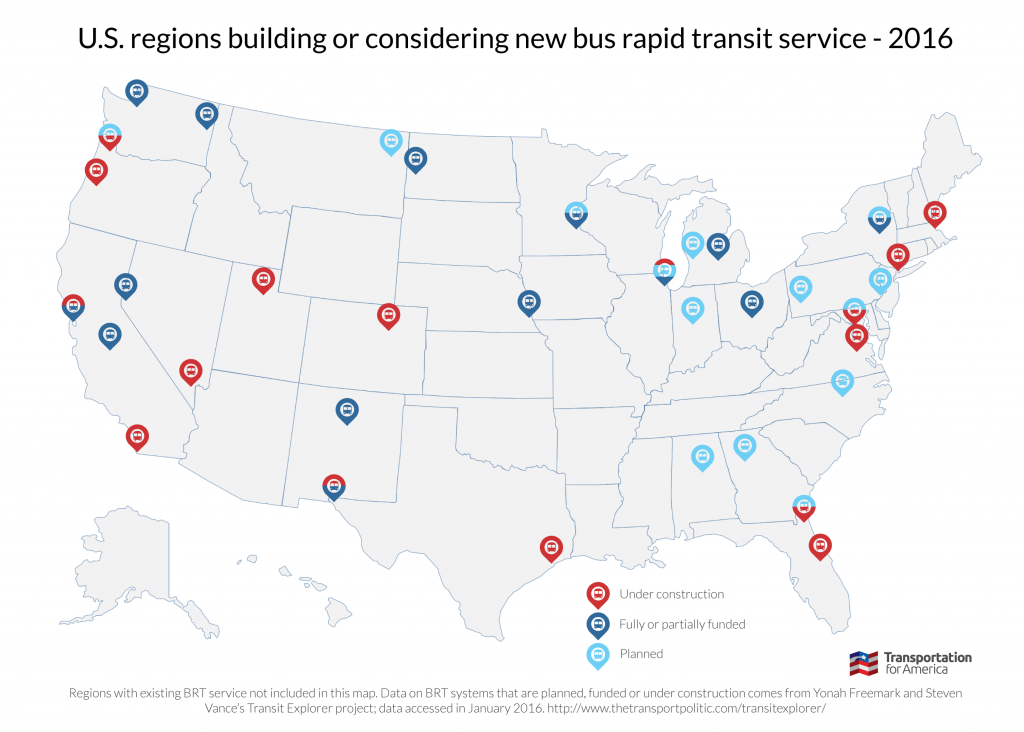New study finds positive economic development benefits associated with bus rapid transit projects
Today T4America unveiled the findings of a new peer-reviewed study that examined existing bus rapid transit (BRT) lines and found strong evidence that BRT systems in the U.S. can indeed generate economic development, attract jobs, retail and affordable housing — at a cost that’s well within reach for many mid-size American cities.
Bus rapid transit is a type of bus service that travels faster and more reliably by providing level boarding, triggering traffic signals, providing pre-board fare payment and running in dedicated lanes separated from traffic, among other typical characteristics. For the first time, a new peer-reviewed research study, unveiled this morning, provides compelling evidence that BRT — often with a price tag far lower than other transit investments — can provide ample economic benefits for cities large and small.
The study, authored by Arthur C. (Chris) Nelson and published by the National Institute for Transportation and Communities (NITC) at Portland State University, was publicly released this morning in an event held by Transportation for America, Smart Growth America’s TOD Technical Assistance Initiative and NITC.
Interested in learning more? Couldn’t make our in-person event today in Washington, DC? We’ll be going over the findings in detail again in an online presentation on Monday, January 25, at 3:30 Eastern time. It’s free and open to all, so register today.
All across the US, interest in bus rapid transit is booming as a smart, more affordable transit option. According to data gathered by Yonah Freemark and Steven Vance for Transit Explorer, more than 30 U.S. regions in at least 24 states are either building or actively considering building new bus rapid transit lines in 2016 and beyond.

But there have been notable gaps in the research on the possible benefits — until now.
What does the study have to say about the economic benefits of BRT?
BRT encourages new office growth in locations connected to transit.
The areas within a half-mile of BRT corridors increased their share of new office space by one third from 2000-2007, and new multifamily apartment construction doubled in those half-mile areas since 2008. For most areas studied, there was a rent premium for office space within a BRT corridor.
BRT corridors fared better than other areas after the recession.
During the economic recovery following the 2008 recession, these corridors also increased their share of office space by one third, and more higher-wage job growth occurred near BRT stations than occurred in central counties. During the economic recovery, BRT station areas saw the largest positive shift in the share of upper-wage jobs, and employment in the manufacturing sector increased.
“Unlike the presumptions of some, bus rapid transit systems have important effects on metropolitan development patterns,” report author Dr. Arthur C. Nelson said in the study. “At substantially lower costs, BRT generates important and sometimes impressive development outcomes.”
To that end, Mayor Gregory Ballard, the recently departed Mayor of Indianapolis and a guest speaker at this morning’s event, noted that a new bus rapid transit network is one of his city’s primary economic competitiveness strategies.
“170,000 employees work within walking distance of our planned Red Line bus rapid transit service — one out of every five employees in the region,” Mayor Ballard said. “We have existing bus service, but it doesn’t go to where the existing jobs are. Providing a way to connect more people to more jobs in the region via a lower-cost, fast, flexible transportation option like bus rapid transit is a smart economic move to ensure that our growing region prospers for years to come.”
At the event, the Hon. Chris Zimmerman, Vice President for Economic Development at Smart Growth America, referenced work that Smart Growth America performed to quantify those potential economic benefits.
“A fiscal analysis we conducted for Indianapolis showed substantial benefits in terms of municipal revenues and costs if future development could be attracted to areas around their new bus rapid transit stations,” Zimmerman said. “It’s this kind of potential that is generating increasing interest in BRT, especially in mid-size cities.” Zimmerman directs the National Public Transportation/Transit-Oriented Development Technical Assistance initiative which Smart Growth America is leading in partnerships with the Federal Transit Administration.
The Hon. John Robert Smith, Transportation for America Advisory Board Chair, noted that Indianapolis is far from alone, supporting Dr. Nelson’s assertion that BRT could represent a large share of new high-quality transit investment for the next few decades.
“These findings are an affirmation for the scores of other can-do regions that bus rapid transit is a smart investment that can indeed bring tangible economic returns. The mayors and other elected officials I meet with on a regular basis are intensely concerned with connecting their residents to jobs, and evidence like this will bolster their efforts to use BRT as a tool to do so,” Smith added.
The full study can be downloaded here.
—-
The study was published by the National Institute of Transportation and Communities at Portland State University and was funded partially through a grant from Transportation for America. Dr. Nelson, who began the study at the University of Utah’s Metropolitan Research Center, is currently Professor of Planning & Real Estate Development at the University of Arizona.
SGA’s TOD Technical Assistance Initiative is made possible through support from the Federal Transit Administration.




















Pingback: New Evidence That Bus Rapid Transit Done Right Spurs Development | Streetsblog USA
Pingback: New Evidence That Bus Rapid Transit Done Right Spurs Development
Pingback: Today’s Headlines | Streetsblog St. Louis
Pingback: (Not quite so) Terse Tuesday Tidbits January 19, 2016 – Politics Plus